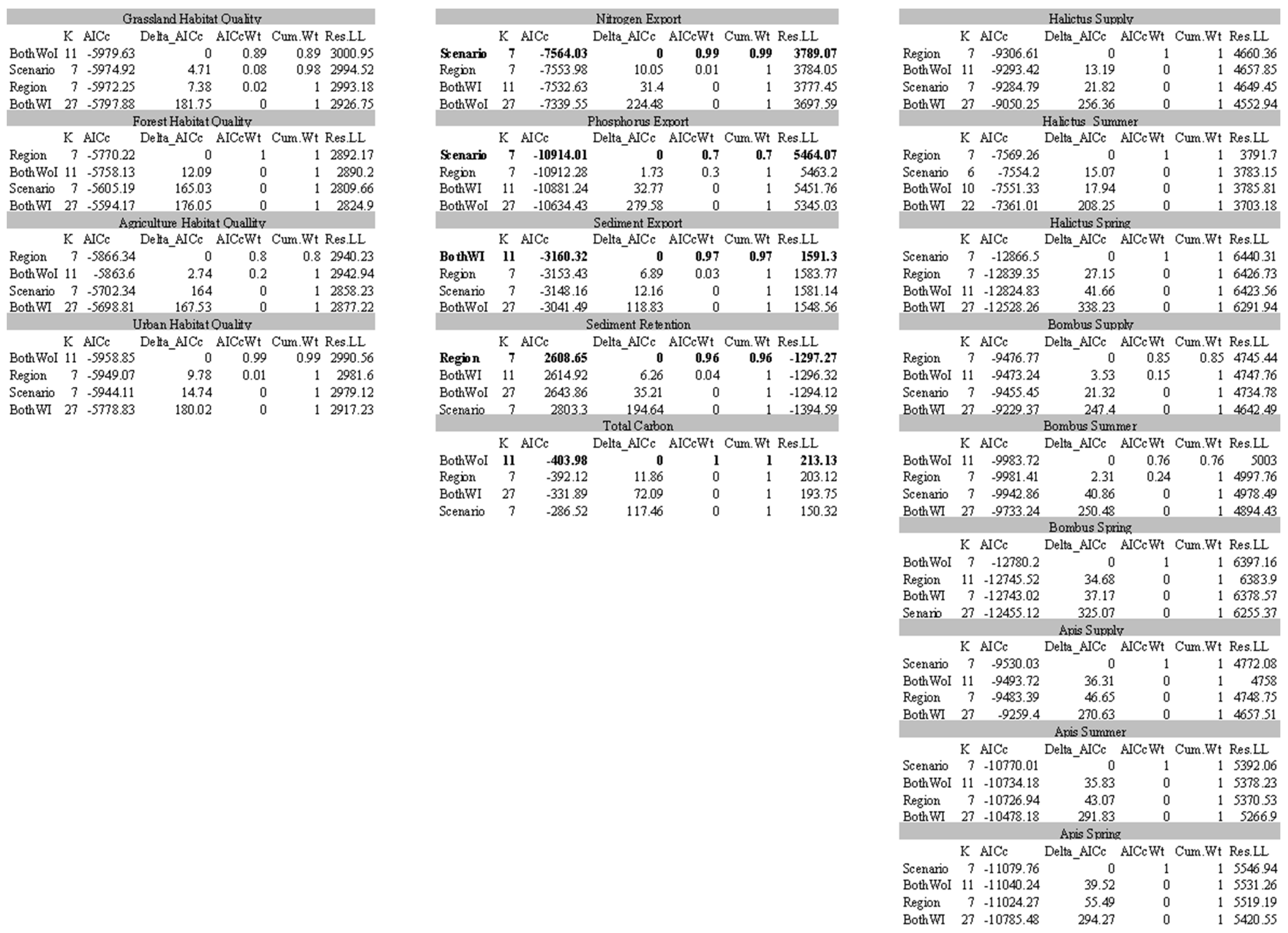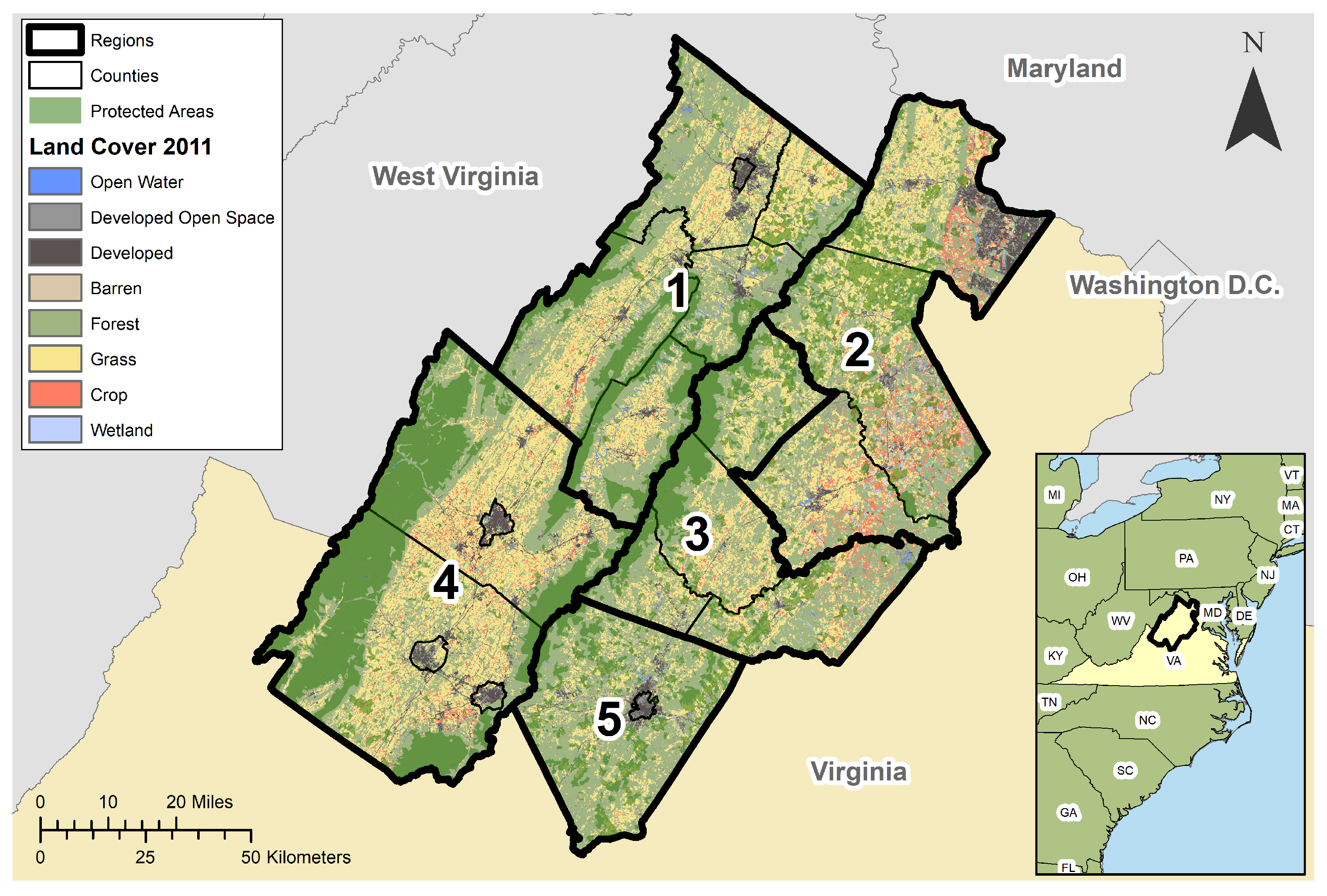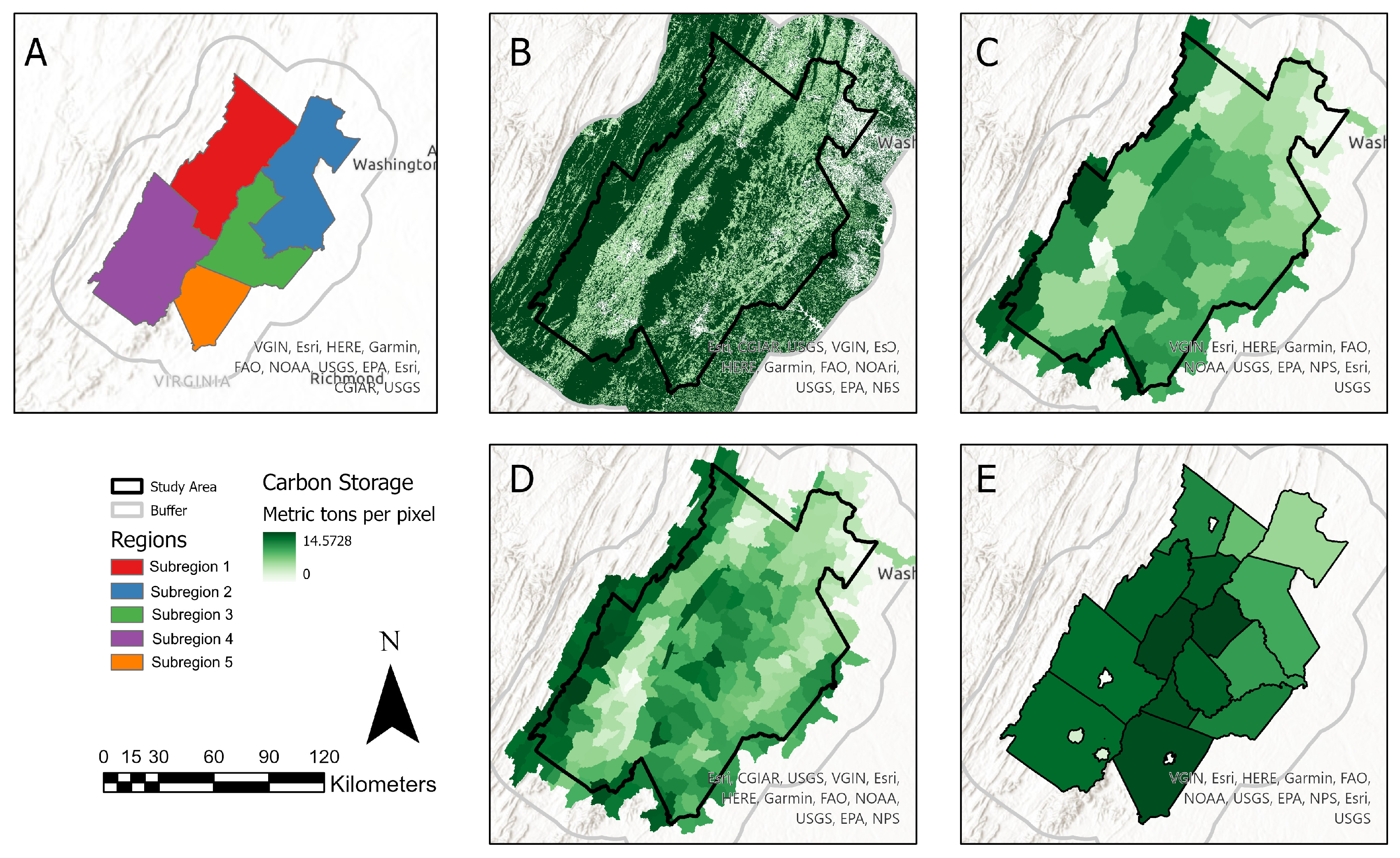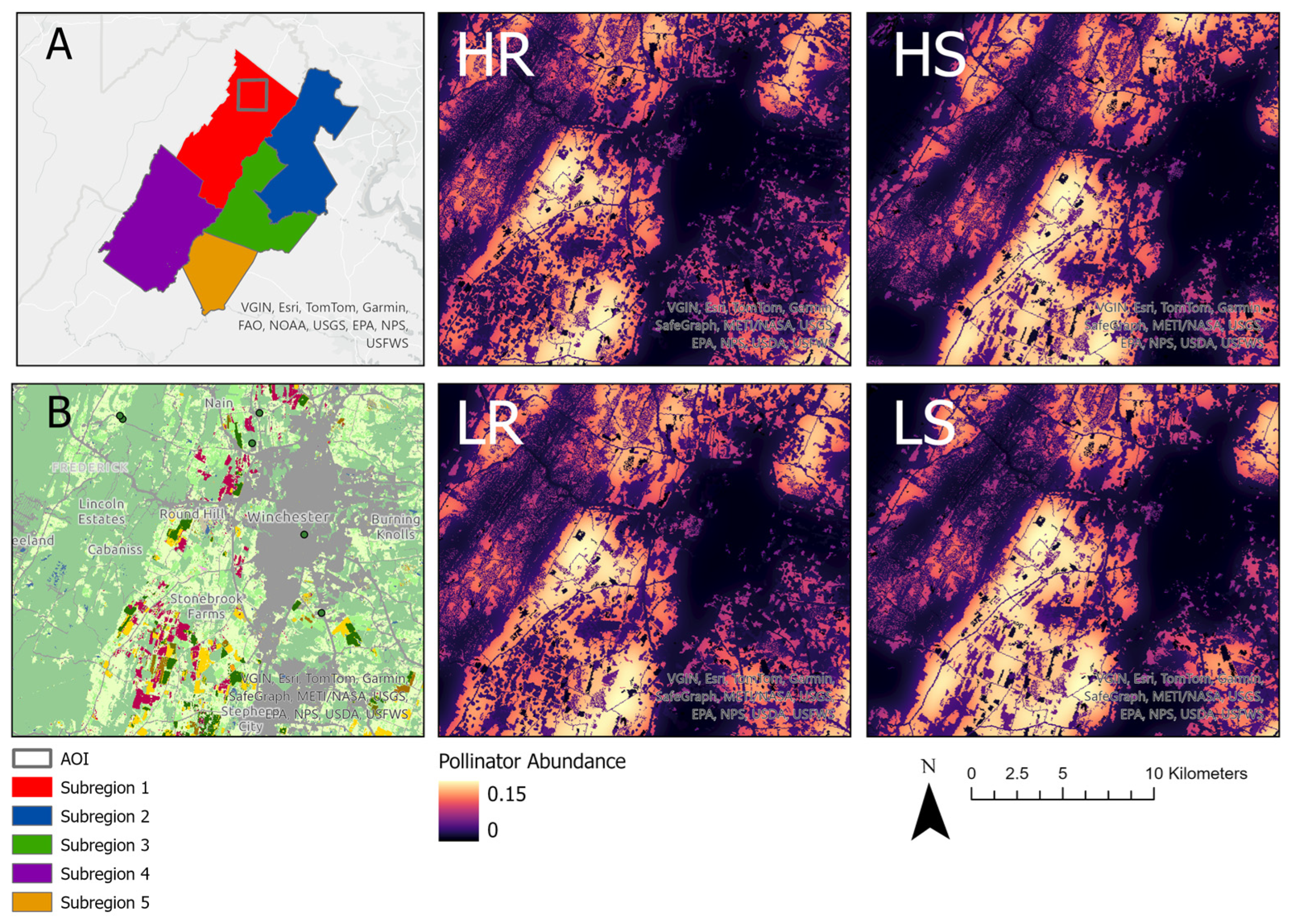Ecosystem Service and Biodiversity Patterns Observed across Co-Developed Land Use Scenarios in the Piedmont: Lessons Learned for Scale and Framing
Abstract
:1. Introduction
2. Materials and Methods
2.1. Study Area
2.2. LULC Scenario Data Collection
2.3. Biodiversity and Ecosystem Service Modeling
2.4. Biodiversity and Ecosystem Service Analysis
3. Results
3.1. Variation by Scale of Analysis
3.2. Model Selection Results
4. Discussion
5. Conclusions
Author Contributions
Funding
Data Availability Statement
Acknowledgments
Conflicts of Interest
Appendix A

References
- Zhao, C.; Sander, H.A.; Hendrix, S.D. Wild bees and urban agriculture: Assessing pollinator supply and demand across urban landscapes. Urban Ecosyst. 2019, 22, 455–470. [Google Scholar] [CrossRef]
- Brown, M.G.; Quinn, J.E. Zoning does not improve the availability of ecosystem services in urban watersheds. A case study from Upstate South Carolina, USA. Ecosyst. Serv. 2018, 34, 254–265. [Google Scholar] [CrossRef]
- Polasky, S.; Crépin, A.S.; Biggs, R.; Carpenter, S.R.; Folke, C.; Peterson, G.; Scheffer, M.; Barrett, S.; Daily, G.; Ehrlich, P.; et al. Corridors of clarity: Four principles to overcome uncertainty paralysis in the anthropocene. BioScience 2020, 70, 1139–1144. [Google Scholar] [CrossRef] [PubMed]
- Rounsevell, M.D.; Arneth, A.; Brown, C.; Cheung, W.W.; Gimenez, O.; Holman, I.; Leadley, P.; Luján, C.; Mahevas, S.; Maréchaux, I.; et al. Identifying uncertainties in scenarios and models of socio-ecological systems in support of decision-making. One Earth 2021, 4, 967–985. [Google Scholar] [CrossRef]
- Nelson, E.; Mendoza, G.; Regetz, J.; Polasky, S.; Tallis, H.; Cameron, D.; Chan, K.M.; Daily, G.C.; Goldstein, J.; Kareiva, P.M.; et al. Modeling multiple ecosystem services, biodiversity conservation, commodity production, and tradeoffs at landscape scales. Front. Ecol. Environ. 2009, 7, 4–11. [Google Scholar] [CrossRef]
- Wing, I.S.; Monier, E.; Stern, A.; Mundra, A. US major crops’ uncertain climate change risks and greenhouse gas mitigation benefits. Environ. Res. Lett. 2015, 10, 115002. [Google Scholar] [CrossRef]
- Terando, A.J.; Costanza, J.; Belyea, C.; Dunn, R.R.; McKerrow, A.; Collazo, J.A. The southern megalopolis: Using the past to predict the future of urban sprawl in the Southeast US. PLoS ONE 2014, 9, e102261. [Google Scholar] [CrossRef]
- Gibson, D.M.; Quinn, J.E. Application of anthromes to frame scenario planning for landscape-scale conservation decision making. Land 2017, 6, 33. [Google Scholar] [CrossRef]
- Quinn, J.E.; Wood, J. Application of a coupled human-natural system framework to identify challenges and opportunities for conservation in private lands. Ecol. Soc. 2017, 22, 39. [Google Scholar] [CrossRef]
- Di Marco, M.; Watson, J.E.; Possingham, H.P.; Venter, O. Limitations and trade-offs in the use of species distribution maps for protected area planning. J. Appl. Ecol. 2017, 54, 402–411. [Google Scholar] [CrossRef]
- Dutra Silva, L.; Brito de Azevedo, E.; Vieira Reis, F.; Bento Elias, R.; Silva, L. Limitations of species distribution models based on available climate change data: A case study in the Azorean forest. Forests 2019, 10, 575. [Google Scholar] [CrossRef]
- Ureta, J.C.; Clay, L.; Motallebi, M.; Ureta, J. Quantifying the landscape’s ecological benefits—An analysis of the effect of land cover change on ecosystem services. Land 2020, 10, 21. [Google Scholar] [CrossRef]
- Sharp, R.; Tallis, H.T.; Ricketts, T.; Guerry, A.D.; Wood, S.A.; Chaplin-Kramer, R.; Nelson, E.; Ennaanay, D.; Wolny, S.; Olwero, N.; et al. InVEST User’s Guide; The Natural Capital Project: Stanford, CA, USA, 2014. [Google Scholar]
- Lacher, I.; Akre, T.; McShea, W.J.; McBride, M.; Thompson, J.R.; Fergus, C. Engaging regional stakeholders in scenario planning for the long-term preservation of ecosystem services in Northwestern Virginia. Case Stud. Environ. 2019, 3, 1–13. [Google Scholar] [CrossRef]
- Lacher, I.; Fergus, C.; McShea, W.J.; Plisinski, J.; Morreale, L.; Akre, T.S. Modeling alternative future scenarios for direct application in land use and conservation planning. Conserv. Sci. Pract. 2023, 5, e12940. [Google Scholar] [CrossRef]
- Tengö, M.; Brondizio, E.S.; Elmqvist, T.; Malmer, P.; Spierenburg, M. Connecting diverse knowledge systems for enhanced ecosystem governance: The multiple evidence base approach. Ambio 2014, 43, 579–591. [Google Scholar] [CrossRef] [PubMed]
- Baston, D. exactextractr: Fast Extraction from Raster Datasets Using Polygons. R Package Version 0.8.2. 2022. Available online: https://CRAN.R-project.org/package=exactextractr (accessed on 9 August 2024).
- Moore, R.B.; McKay, L.D.; Rea, A.H.; Bondelid, T.R.; Price, C.V.; Dewald, T.G.; Johnston, C.M. User’s Guide for the National Hydrography Dataset Plus (NHDPlus) High Resolution; Open-File Report 2019-1096; U.S. Geological Survey: Reston, VA, USA, 2019; 66p. [Google Scholar] [CrossRef]
- Bates, D.; Maechler, M.; Bolker, B.; Walker, S.; Christensen, R.H.B.; Singmann, H.; Dai, B.; Grothendieck, G.; Green, P.; Bolker, M.B. Package ‘lme4’. Convergence 2015, 12, 2. [Google Scholar]
- Quinn, C.E.; Quinn, J.E.; Halfacre, A.C. Digging deeper: A case study of farmer conceptualization of ecosystem services in the American South. Environ. Manag. 2015, 56, 802–813. [Google Scholar]
- Hallett, L.M.; Morelli, T.L.; Gerber, L.R.; Moritz, M.A.; Schwartz, M.W.; Stephenson, N.L.; Tank, J.L.; Williamson, M.A.; Woodhouse, C.A. Navigating translational ecology: Creating opportunities for scientist participation. Front. Ecol. Environ. 2017, 15, 578–586. [Google Scholar]
- Ordway, E.M.; Elmore, A.J.; Kolstoe, S.; Quinn, J.E.; Swanwick, R.; Cattau, M.; Taillie, D.; Guinn, S.M.; Chadwick, K.D.; Atkins, J.W.; et al. Leveraging the NEON Airborne Observation Platform for socio-environmental systems research. Ecosphere 2021, 12, e03640. [Google Scholar] [CrossRef]
- Groves, C.R.; Game, E.T. Conservation Planning: Informed Decisions for a Healthier Planet; Roberts and Company Publishers: Greenwood Village, CO, USA, 2016. [Google Scholar]
- Samir, K.C.; Wolfgang, L. The human core of the shared socioeconomic pathways: Population scenarios by age, sex and level of education for all countries to 2100. Glob. Environ. Chang. 2017, 42, 181–192. [Google Scholar]
- Cooley, D.; Olander, L. Stacking ecosystem services payments: Risks and solutions. Envtl. L. Rep. News Anal. 2012, 42, 10150. [Google Scholar]
- Klain, S.C.; Satterfield, T.A.; Chan, K.M. What matters and why? Ecosystem services and their bundled qualities. Ecol. Econ. 2014, 107, 310–320. [Google Scholar]
- Saidi, N.; Spray, C. Ecosystem services bundles: Challenges and opportunities for implementation and further research. Environ. Res. Lett. 2018, 13, 113001. [Google Scholar]



| Apis Supply | Apis Spring | Apis Summer | Bombas Supply | Bombas Spring | Bombas Summer | Halitctus Supply | Halitctus Spring | Halitctus Summer | ||||||||||
| Est | SE | Est | SE | Est | SE | Est | SE | Est | SE | Est | SE | Est | SE | Est | SE | Est | SE | |
| Intercept | −0.0013 | 0.0002 | −0.0007 | 0.0001 | −0.0006 | 0.0001 | 0.0003 | 0.0005 | −0.00019 | 0.00004 | 0.0002 | 0.0004 | 0.0003 | 0.0005 | −0.0002 | 0.00004 | 0.0001 | 0.0005 |
| ChangeHS | 0.0003 | 0.0001 | 0.0001 | 0.0001 | 0.0001 | 0.0001 | 0.00005 | 0.00002 | 0.0002 | 0.0001 | 0.0000 | 0.00002 | ||||||
| ChangeHR | −0.0001 | 0.0001 | −0.0001 | 0.0001 | 0.0000 | 0.0001 | 0.00000 | 0.00002 | 0.0001 | 0.0001 | 0.0000 | 0.00002 | ||||||
| ChangeLR | 0.0006 | 0.0001 | 0.0003 | 0.0001 | 0.0004 | 0.0001 | 0.00014 | 0.00002 | 0.0006 | 0.0001 | 0.0001 | 0.00002 | ||||||
| ChangeLS | 0.0008 | 0.0001 | 0.0004 | 0.0001 | 0.0004 | 0.0001 | 0.00014 | 0.00002 | 0.0005 | 0.0001 | 0.0001 | 0.00002 | ||||||
| Region2 | 0.0013 | 0.0007 | 0.0012 | 0.0006 | 0.0012 | 0.0008 | 0.0011 | 0.0007 | ||||||||||
| Region3 | −0.0001 | 0.0006 | −0.0005 | 0.0004 | −0.0002 | 0.0006 | 0.0001 | 0.0006 | ||||||||||
| Region4 | −0.0032 | 0.0007 | −0.0029 | 0.0005 | −0.0033 | 0.0007 | −0.0027 | 0.0006 | ||||||||||
| Region5 | 0.0005 | 0.0010 | 0.0003 | 0.0008 | 0.0005 | 0.0010 | 0.0004 | 0.0009 | ||||||||||
| Total Carbon | Nitrogen Export | Phosphorous Export | Sediment Export | Sediment Retention | ||||||||||||||
| Est | SE | Est | SE | Est | SE | Est | SE | Est | SE | |||||||||
| Intercept | −0.4265 | 0.0473 | 0.0032 | 0.0005 | 0.0008 | 0.0001 | 0.0251 | 0.0173 | 2.0735 | 0.2744 | ||||||||
| ChangeHS | 0.0189 | 0.0136 | 0.0008 | 0.0003 | 0.0000 | 0.0001 | 0.0032 | 0.0028 | ||||||||||
| ChangeHR | −0.0187 | 0.0136 | −0.0004 | 0.0003 | 0.0000 | 0.0001 | 0.0013 | 0.0028 | ||||||||||
| ChangeLR | 0.0369 | 0.0136 | −0.0015 | 0.0003 | −0.0003 | 0.0001 | 0.0161 | 0.0028 | ||||||||||
| ChangeLS | 0.0693 | 0.0136 | −0.0005 | 0.0003 | −0.0003 | 0.0001 | 0.0140 | 0.0028 | ||||||||||
| Region2 | −0.0718 | 0.0670 | −0.0325 | 0.0240 | 0.7308 | 0.3906 | ||||||||||||
| Region3 | 0.5250 | 0.0597 | −0.0365 | 0.0155 | −2.1750 | 0.3131 | ||||||||||||
| Region4 | 0.4036 | 0.0637 | −0.1177 | 0.0233 | −3.2922 | 0.3747 | ||||||||||||
| Region5 | 0.0912 | 0.0898 | −0.0329 | 0.0350 | −0.5958 | 0.5420 | ||||||||||||
| Urban Hab. Qual. | Agriculture H. Qual. | Forest H. Qual. | Grassland H. Qual. | |||||||||||||||
| Est | SE | Est | SE | Est | SE | Est | SE | |||||||||||
| Intercept | 0.0047 | 0.0031 | −0.0277 | 0.0030 | −0.0284 | 0.0032 | 0.0032 | 0.0030 | ||||||||||
| ChangeHS | 0.0013 | 0.0007 | 0.0013 | 0.0007 | ||||||||||||||
| ChangeHR | 0.0004 | 0.0007 | 0.0003 | 0.0007 | ||||||||||||||
| ChangeLR | 0.0045 | 0.0007 | 0.0043 | 0.0007 | ||||||||||||||
| ChangeLS | 0.0040 | 0.0007 | 0.0040 | 0.0007 | ||||||||||||||
| Region2 | −0.0019 | 0.0044 | −0.0033 | 0.0044 | −0.0046 | 0.0046 | −0.0024 | 0.0042 | ||||||||||
| Region3 | −0.0083 | 0.0034 | 0.0373 | 0.0036 | 0.0383 | 0.0038 | −0.0063 | 0.0034 | ||||||||||
| Region4 | −0.0240 | 0.0042 | 0.0334 | 0.0042 | 0.0333 | 0.0044 | −0.0219 | 0.0041 | ||||||||||
| Region5 | −0.0005 | 0.0061 | 0.0071 | 0.0060 | 0.0069 | 0.0063 | 0.0002 | 0.0059 | ||||||||||
Disclaimer/Publisher’s Note: The statements, opinions and data contained in all publications are solely those of the individual author(s) and contributor(s) and not of MDPI and/or the editor(s). MDPI and/or the editor(s) disclaim responsibility for any injury to people or property resulting from any ideas, methods, instructions or products referred to in the content. |
© 2024 by the authors. Licensee MDPI, Basel, Switzerland. This article is an open access article distributed under the terms and conditions of the Creative Commons Attribution (CC BY) license (https://creativecommons.org/licenses/by/4.0/).
Share and Cite
Quinn, J.E.; Fergus, C.; Hyland, E.; Vickery, C.; Lacher, I.L.; Akre, T.S. Ecosystem Service and Biodiversity Patterns Observed across Co-Developed Land Use Scenarios in the Piedmont: Lessons Learned for Scale and Framing. Land 2024, 13, 1340. https://doi.org/10.3390/land13091340
Quinn JE, Fergus C, Hyland E, Vickery C, Lacher IL, Akre TS. Ecosystem Service and Biodiversity Patterns Observed across Co-Developed Land Use Scenarios in the Piedmont: Lessons Learned for Scale and Framing. Land. 2024; 13(9):1340. https://doi.org/10.3390/land13091340
Chicago/Turabian StyleQuinn, John E., Craig Fergus, Emilia Hyland, Caroline Vickery, Iara L. Lacher, and Thomas S. Akre. 2024. "Ecosystem Service and Biodiversity Patterns Observed across Co-Developed Land Use Scenarios in the Piedmont: Lessons Learned for Scale and Framing" Land 13, no. 9: 1340. https://doi.org/10.3390/land13091340





